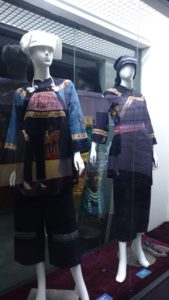The Shanghai Textile Museum 上海纺织博物馆 150 Aomen Rd; 澳門路150号(right near the M50 art district) is not one of the most famous museums in China. Lonely Planet dismisses it as “The sort of place visitors got taken to in the 1980s before China fully opened to tourism,” Ouch. Is it the best museum in China?
No, No, and Yes.
First the nos. One thing that can make a great museum is to have something great to build it around. The Forbidden City. Qin Shihaung’s grave. You basically can’t mess something like that up. This site is just a modern building in what used to be the old textile district. Another thing that can make a great museum is great story-telling. Ideally a good museum has lots of text that, together with artifacts, tells a bunch of stories and says something about history. The Chinese text here is not that good, and the English text is often terrible.
The yes is that they have a good idea and a good collection. This is the most complete “built” museum I can think of in China.1 Textiles are the story of Shanghai, and while parts of this could be better done, they cover almost everything. This is as close to a museum of the social history of Shanghai as you will find.
They go back the the very beginning of textile history, but the collection really begins with Late Imperial Songjiang and its cotton growing spinning and weaving. This section is helped by the Chinese willingness to use reproduction artifacts and cheesy dioramas more than American museums usually like to. This is also the section you are most likely to find pictures of on the web, as it is the most “traditional China” part of the place and the most likely to get pictures from tourists.
For me of course the best part are the modern sections. Shanghai was the Treaty Port, and textiles were the center of both foreign and Chinese controlled industrialization, and the birthplace of the Chinese working class. This is a bit complex for a Chinese museum to deal with. Foreign imperialism is of course bad, although you can certainly brag about Shanghai’s growing industrial clout. The museum has displays on both the early Chinese textile capitalists and the workers movement. They don’t do much to explain how these relate, but that might be asking a bit much
They also have a lot on consumption. Shanghai did not just produce textiles, they bought them and set trends for the whole country.
Of course while there is a lot of Republican era stuff, there is also lots of later stuff. In 1949 New China was established, and the workers of the Shanghai textile industry took center stage. We get lost of model workers, visits from every important leader
Visiting delegations of workers from around the world
The Cultural Revolution is skipped over, and this section has less explanation than a lot of the earlier ones, but still there is a lot of stuff on Worker’s China here.
With reform and opening up Shanghai remained of central importance. The rustbelt communist industries of Manchuria were quickly left behind, but textiles and light manufacturing were at the forefront of China’s exports. If you want to see boxes of Three Guns underwear from the 1980’s this is the place to go.2
Eventually, of course, the textile industry was moved out out its prime real estate location, and at least according to the pictures attempts to find new jobs for the textile workers were a great success
Finally there is a whole floor on modern textiles and science and such. And, of course, an exhibit on the colorful costumes of minority groups.
Parts of this are less good than they could be. The science part could use a lot more explanation. It is good that I can now tell serge from seersucker, but how are they made and when do you use them? Given that almost all the worker photos are of women, one would like some more focus on gender. Still, the museum does touch on almost every aspect of Shanghai textile history, and by following this thread3 they touch on almost every aspect of Shanghai. Admittedly it is a place that requires you to do a lot of the work yourself in figuring out why these things matter. Still, they do more to construct a story than most museums I can think of.










3 Comments